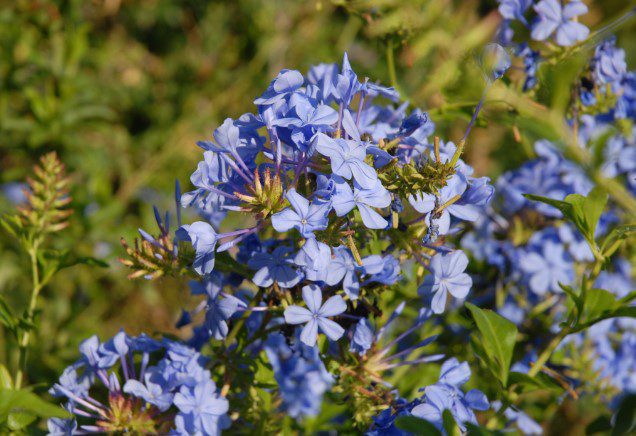Plumbago Auriculata
Plumbago is a sprawling South African shrub that grows three feet to five feet tall on sunny, well-drained sites. Freezes damage it but recover.
Plumbago auriculata or cape plumbago is one of many ornamental shrubs that flourish in Redlands. This robust shrub, a member of the Plumbaginaceae family, has been around since Roman times.
The cape plumbago, a perennial evergreen that is native to South Africa and is a native species. The cape plumbago is a prolific grower, and it blooms in spectacular phlox-like clusters filled with delicate light sky blue flowers. Children often wear sticky cape plumbago flowers as earrings in summer.
Plumbago auriculata, a low-maintenance mounding shrub of pale green that thrives in neglect, is an example.
It can withstand almost any type of soil, as well as full sun and partial shade. Once established, it requires only average watering but is drought-tolerant.
The cape plumbago flower best when it is planted in well-drained, humus-rich soil and given full sun. Regular watering is essential.
The plant will bloom after it has been cut back or after a growth flush. It bears new growth and flowers after being cut back. Deadheading seems to accelerate reblooming.
Cape plumbago can grow quickly and reach up to 3-8 feet tall with a similar spread. However, it can be kept compact and low with trimming. Cape plumbago attracts birds and butterflies but is not usually affected by diseases or pests.
Plumbago auriculata can be found in parks, gardens, and other landscapes all over the globe. Because of its natural sprawling habit, it is easy to trim and prune. This makes Plumbago auriculata a great choice for large parks, slopes, gardens, and road dividers.
With its abundant blue flowers, the cape plumbago has been used in many other applications, including groundcovers and compact mounded shrubs.
Cape plumbago can also be propagated by cuttings or seeds. It is used to treat warts, broken bones, and wounds and dispel bad dreams in some areas.
Medicinal uses
For centuries, plumbago was known as leadwort because it was thought to cure lead poisoning (it doesn’t).
The genus name of plumbago is also linked to lead — the Latin name for lead is “plumbum”. The word “plum” for lead also turns up in our language with plum lines and plum bobs — lines weighted with a lead ball.
This link between plumbago and lead dates from the concept of complementary medicine when some physical property of a plant, such as a shape or colour of its flower or leaf, was seen as resembling part of the body or some other feature of the disease.
It was the soft blue coloured flowers of plumbago that led to the link with lead.
Though plumbago is ineffective against lead poisoning, some species, including P. zeylanica, are considered to have some medicinal value — but it can also be harmful to the liver and kidneys.
Colours of Plumbago Auriculata
While the species has pale blue flowers, which is the most commonly seen in gardens, there are other flower colours, including white (alba) and a deep, almost forget-me-not blue sold as a royal cape.
As well as having stronger blue coloured blooms, the royal cape is less prone to suckering than the species, making it a more garden-friendly plant.
It can also be cultivated in a large pot or raised garden bed.
PLANT PROFILE: PLUMBAGO
- Scientific name: Plumbago auriculata.
- Growth habit: A rounded spreading shrub growing to 4 feet tall and wide. The leaves are light green and oblong to 2 inches long.
- Light: Growing and flowers best in full sun but can withstand light shade.
Water needs Drought tolerant; water frequently until roots grow into the soil; established shrubs get adequate moisture from seasonal rains. - Feedings: Apply a general garden fertilizer in March, June, and October if needed to encourage growth. Many plants grow with the nutrients from decomposing mulches.
- Propagation: From cuttings.
- Ease of culture: Easy.
- Hardiness: Hardy; during severe freezes, stems may be frozen to the ground, but plants resume growth from buds at or below the soil line.
- Major problems: Shoots can sprout from the roots. Plants can be affected by scale insects and mites—control as needed with an oil spray. If grown in alkaline soils, minor nutrient deficiencies may be noted, and nutrient treatments often are needed.
- Pruning: Trim periodically to keep in bounds. Remove declining stems affected by cold at the end of February.
- Use: A durable shrub for any landscape but especially useful in drier sites and harder to care for. Plantings produce a continual display of blue to white flowers except when affected by the cold.
Use as a ground cover for large open areas, cluster near foundations, grow as small hedges, and use a plant or two to fill container gardens and planters.
Native to South Africa.


























